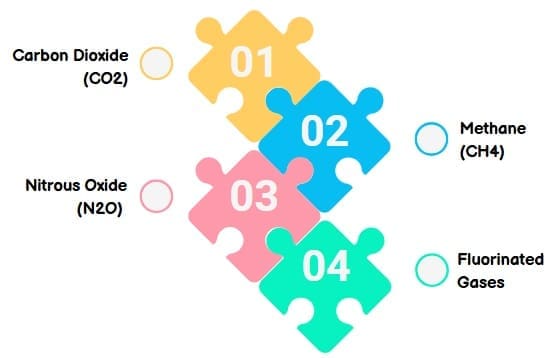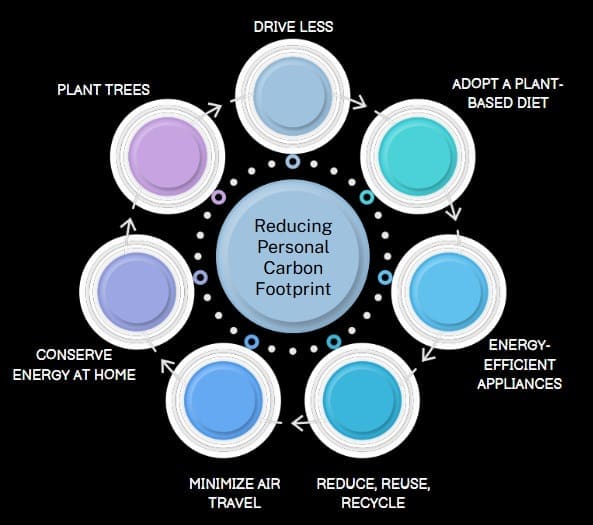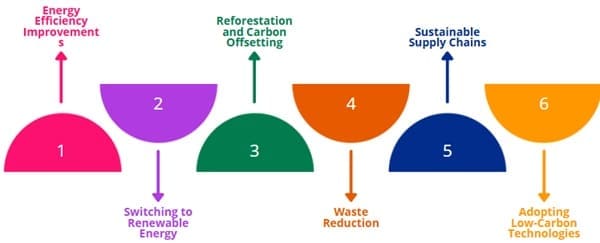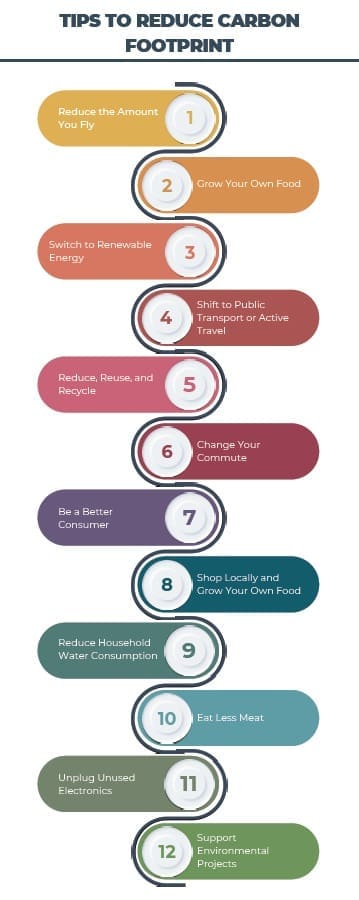A carbon footprint refers to the total greenhouse gas (GHG) emissions caused by a person, event, organization, product, or service. These emissions are typically expressed in terms of carbon dioxide equivalents.
Greenhouse gases like carbon dioxide (CO2), methane (CH4), and nitrous oxide (N2O) are primarily released through human activities, such as burning fossil fuels, deforestation, and manufacturing processes. These gases trap heat in the Earth’s atmosphere, contributing to global warming and climate change.
Reducing one’s carbon footprint is crucial to mitigate climate change and reduce the negative impact on the environment. This article will explore the concept of carbon footprints, the common greenhouse gases involved, and practical ways individuals and industries can reduce their carbon emissions.
Table of contents
What is a Carbon Footprint?
A carbon footprint is the total amount of greenhouse gases emitted by human activities, such as transportation, energy consumption, and food production. These emissions are measured in terms of CO2 equivalents (CO2e), allowing various gases to be compared based on their global warming potential.
Human activities, particularly the burning of fossil fuels for energy, significantly increase the concentration of greenhouse gases in the atmosphere. As a result, the Earth’s temperature is rising, leading to climate change, rising sea levels, and extreme weather events.
Common Greenhouse Gases

Several greenhouse gases contribute to global warming. The most common include:
- Carbon Dioxide (CO2): The most abundant greenhouse gas, primarily released through the burning of fossil fuels like coal, oil, and natural gas.
- Methane (CH4): Released during the production of oil and natural gas, agriculture (especially livestock), and landfill decomposition.
- Nitrous Oxide (N2O): Emitted from agricultural practices, including the use of fertilizers and livestock management.
- Fluorinated Gases: Synthetic gases used in refrigeration, air conditioning, and manufacturing processes.
These gases trap heat in the atmosphere, causing the Earth’s temperature to rise, leading to the phenomena we know as global warming.
How is a Carbon Footprint Measured?
The carbon footprint of an individual, organization, or product can be measured through a process called carbon accounting. This involves calculating the total emissions from various activities, such as energy consumption, transportation, and food production.
Tools such as carbon footprint calculators, which are available online, help individuals estimate their personal carbon emissions. Individuals can get a rough idea of their carbon footprint by answering questions about daily activities, including transportation choices, home energy use, and diet.
For businesses, carbon footprints are often calculated using Life Cycle Assessments (LCA) or the Greenhouse Gas (GHG) Protocol. These methods assess the emissions generated by a product or service throughout its lifecycle, from raw material extraction to end-of-life disposal.
Direct vs. Indirect Carbon Emissions
Direct Emissions (Scope 1 and Scope 2): These emissions come directly from activities or sources owned or controlled by the entity. For example, emissions from burning fuel in a car or heating a building with natural gas fall under direct emissions.
- Scope 1: Direct emissions from owned or controlled sources, like factory operations.
- Scope 2: Emissions from purchased electricity, steam, or heat.
Indirect Emissions (Scope 3): These are emissions that occur from sources not directly owned or controlled by the entity. For instance, emissions from the production and transportation of goods or services used by a company fall under indirect emissions.
Reducing Personal Carbon Footprint

Individuals can take several actions to reduce their carbon footprints. Some of the most effective methods include:
- Drive Less: Walking, biking, carpooling, and using public transportation can significantly reduce emissions. Avoiding long car trips and unnecessary driving can also help.
- Adopt a Plant-Based Diet: Meat production, especially red meat, has a high carbon footprint due to methane emissions from livestock and energy-intensive farming practices. By switching to plant-based meals, individuals can lower their carbon footprint.
- Energy-Efficient Appliances: Using energy-efficient household appliances, such as LED lights, energy-efficient refrigerators, and washing machines, can reduce electricity consumption and decrease carbon emissions.
- Reduce, Reuse, Recycle: Reducing consumption of single-use plastics, reusing items, and recycling materials like paper, glass, and metal can help reduce emissions associated with manufacturing and waste disposal.
- Minimize Air Travel: Airplanes are one of the largest sources of carbon emissions. Limiting air travel and opting for alternative transportation methods like trains can reduce personal carbon footprints.
- Conserve Energy at Home: Simple actions like turning off lights when not in use, using programmable thermostats, and adding insulation to homes can significantly reduce energy consumption and emissions.
- Plant Trees: Trees absorb CO2 and can offset emissions. Participating in tree-planting programs or supporting reforestation efforts can help mitigate the impact of carbon emissions.
Ways to Reduce Carbon Footprint in Industry

Industries contribute significantly to global carbon emissions. However, there are many strategies that companies can implement to reduce their carbon footprint:
- Energy Efficiency Improvements: By adopting energy-efficient technologies such as LED lighting, smart meters, and energy-efficient heating and cooling systems, companies can reduce energy use and emissions.
- Switching to Renewable Energy: Industries can reduce their reliance on fossil fuels by investing in renewable energy sources like solar, wind, and geothermal. This transition can drastically lower the carbon footprint of operations.
- Reforestation and Carbon Offsetting: Companies can invest in reforestation projects or purchase carbon credits to offset their emissions. This helps balance out the emissions produced by their operations.
- Waste Reduction: Reducing waste production, improving recycling rates, and optimizing manufacturing processes can lower the overall carbon footprint of industries. Efficient use of materials can reduce the energy required to produce goods and services.
- Sustainable Supply Chains: Companies can reduce emissions by sourcing materials from sustainable sources, minimizing transportation emissions, and implementing greener packaging solutions.
- Adopting Low-Carbon Technologies: The use of low-carbon technologies, such as carbon capture and storage (CCS) and advanced manufacturing processes, can help industries significantly reduce their emissions.
Role of Government and Policy
Governments play a vital role in encouraging the reduction of carbon footprints through policies and regulations. These may include:
- Carbon Pricing: Implementing carbon taxes or cap-and-trade systems can provide financial incentives for companies and individuals to reduce emissions.
- Subsidies for Renewable Energy: Governments can promote the use of renewable energy by providing financial incentives or subsidies for companies and households to invest in green technologies.
- Regulations on Emissions: Governments can set emissions standards for industries, transportation, and other sectors to limit their carbon emissions.
Tips to Reduce Carbon Footprint

Simple changes in lifestyle, consumption, and energy usage can lead to significant reductions in CO2 emissions and contribute to a healthier planet.
- Reduce the Amount You Fly
Flying is one of the highest contributors to a person’s carbon footprint. Air travel, especially long-haul flights, releases large amounts of CO2 into the atmosphere. Taking fewer flights can drastically cut down your annual carbon footprint. For example, avoiding one long-haul flight per year can reduce your emissions by over 1.6 tonnes of CO2.
To minimize your carbon footprint, consider alternatives like train travel, carpooling, or even staying closer to home for vacations. If flying is unavoidable, opt for direct flights, as take-offs and landings generate more emissions. Additionally, support airlines that are investing in fuel-efficient technologies or carbon offset programs. - Grow Your Own Food
Growing your own food is an excellent way to reduce your carbon footprint. You don’t need to be an expert gardener to start. Even growing small fruits, vegetables, and herbs can help lower emissions from food transportation. Additionally, homegrown food reduces food waste, which is another contributor to greenhouse gas emissions.
Consider starting with easy-to-grow plants such as tomatoes, lettuce, or herbs. You can even try container gardening if you have limited space. If growing your own food isn’t possible, shop locally and buy from farmers’ markets. Local food has a smaller carbon footprint because it doesn’t need to be transported over long distances. - Switch to Renewable Energy
One of the most impactful ways to lower your carbon footprint is by switching to renewable energy sources. Choose a green energy supplier for your electricity needs. Green energy comes from renewable sources such as wind, solar, or hydroelectric power, which produce little to no emissions.
Additionally, consider installing energy-efficient systems in your home, such as an air-source heat pump instead of a traditional boiler. These alternatives can drastically reduce your reliance on fossil fuels and lower your carbon footprint. Solar panels are another excellent option, although they require an initial investment. - Shift to Public Transport or Active Travel
Transportation is a major source of carbon emissions. Instead of driving alone, consider alternatives like walking, cycling, or using public transportation. Not only does this reduce your carbon footprint, but it also helps reduce traffic congestion and improves your health.
If public transport isn’t available, consider carpooling with friends or colleagues. For short trips, walking or cycling can be great options. In addition to reducing emissions, these activities can also reduce stress and improve mental well-being. - Reduce, Reuse, and Recycle
The 6Rs—Rethink, Refuse, Reduce, Reuse, Repair, and Recycle—are powerful guidelines to help reduce waste and emissions. By thinking carefully about your purchases, you can avoid unnecessary items that contribute to your carbon footprint. Refusing to buy things you don’t need reduces demand for products, which in turn reduces emissions from production and transportation.
Reusing items, like containers or bags, can significantly cut down on waste. Repairing broken items instead of replacing them also prevents new products from being manufactured, saving resources and energy. Finally, recycling ensures that valuable materials are reused, reducing the need for raw material extraction. - Change Your Commute
Commuting by car is a major source of CO2 emissions, especially in areas where driving is the most convenient option. To reduce your carbon footprint, consider switching your daily commute. Walk or bike to work, or take public transportation. Many cities offer programs to make commuting by bike or bus more convenient.
If possible, try working from home. This eliminates the need for commuting altogether, reducing both your carbon emissions and your stress levels. When driving is necessary, consider combining trips or carpooling with others. Avoid idling your car for long periods, as this wastes fuel and increases emissions. - Be a Better Consumer
Becoming a more conscious consumer can significantly reduce your carbon footprint. The average person generates a large amount of waste each day, including plastic and food packaging. To reduce waste, choose reusable bags, bottles, and coffee cups. This simple change eliminates the need for single-use plastic, which is a major contributor to pollution and emissions.
Before making a purchase, ask yourself whether it’s truly necessary. Avoid impulse buys, and choose quality items that last longer. Also, be mindful of the environmental impact of the products you buy. Opt for products made from sustainable materials, and consider buying secondhand whenever possible. - Shop Locally and Grow Your Own Food
Buying locally grown food and supporting local businesses can help reduce your carbon footprint. Food that is transported long distances requires energy to ship, which results in emissions. By purchasing food from local farms, you reduce the energy needed for transportation.
If you have the space, start a small garden to grow your own vegetables. This reduces the need for store-bought produce, which is often packaged in plastic and shipped over long distances. Local, seasonal foods are often fresher, healthier, and more eco-friendly. - Reduce Household Water Consumption
Water usage also contributes to carbon emissions, as it takes energy to pump, treat, and heat water. To reduce your water-related emissions, take shorter showers and fix any leaks promptly. Installing low-flow showerheads and faucets can save both water and energy.
Water-efficient landscaping, like using drought-resistant plants or installing drip irrigation systems, can further reduce your household’s water consumption. Additionally, consider using EnergyStar-rated appliances, which consume less energy and water. - Eat Less Meat
The production of meat, particularly beef, is one of the highest contributors to greenhouse gas emissions. Livestock farming releases large amounts of methane, a potent greenhouse gas. Additionally, the deforestation required to create pastureland adds to the environmental impact.
By reducing your meat consumption, particularly beef, you can make a significant impact. Try adopting a meatless day each week or switching to plant-based alternatives. Even eating less meat in general, such as choosing chicken over beef, can reduce your carbon footprint by a large margin. - Unplug Unused Electronics
Many household electronics consume power even when turned off. This “phantom power” can add up over time, increasing your energy consumption and carbon footprint. Unplug electronics such as chargers, TVs, and home appliances when they are not in use.
Use power strips to make it easier to disconnect multiple devices at once. This small change can help you save energy and lower your monthly electricity bill. - Support Environmental Projects
Another way to reduce your carbon footprint is by supporting local environmental initiatives. Participate in community clean-ups, support tree planting projects, and encourage local governments to focus on sustainability. These efforts can improve air quality, reduce pollution, and create healthier ecosystems.
By actively engaging with environmental projects, you contribute to a larger movement that aims to preserve and protect natural resources for future generations.
Final Words
Reducing your carbon footprint requires a combination of lifestyle changes, mindful consumption, and energy-efficient choices. Every small action counts, whether it’s flying less, growing your own food, or switching to renewable energy.
While individual efforts are important, collective action is necessary to tackle climate change on a larger scale. By making conscious choices today, we can create a more sustainable and healthier world for tomorrow.


















